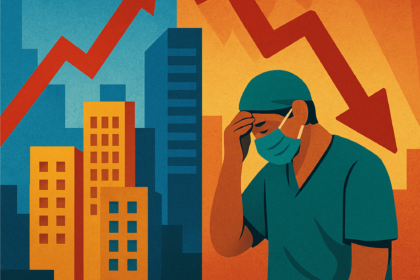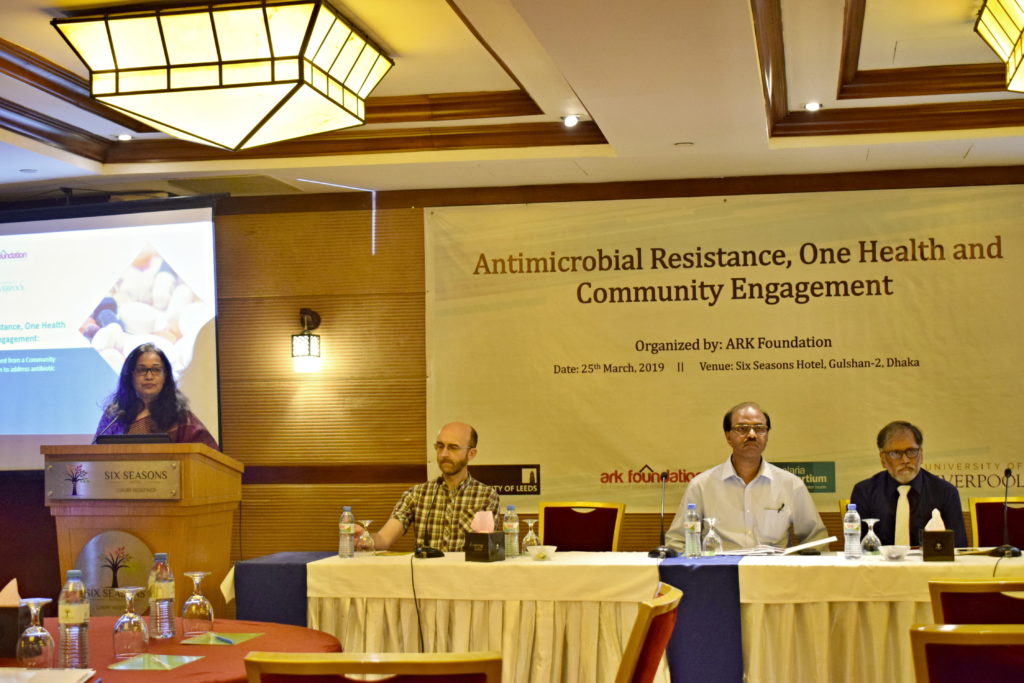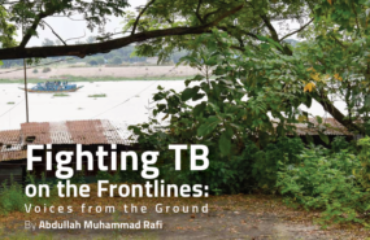
By Abdullah M. Rafi (published in The Business Standard on 15 May, 2025)
Bangladesh, one of the fastest-growing economies in the world according to the World Bank, has identified health as both a priority and a persistent challenge. Article 15(a) of the country’s constitution reflects this commitment by guaranteeing healthcare as a fundamental right for all citizens.
Additionally, Article 18(1) designates the improvement of public health and nutrition as a core responsibility of the State. Since its independence in 1971, Bangladesh has made significant progress in the health sector, including exemplary efforts in eradicating malaria, expanding immunisation coverage, and reducing maternal and child mortality. However, these achievements are often overshadowed by the dysfunction and negative externalities of the health sector, which, according to Transparency International Bangladesh, made it one of the most corrupt sectors in 2022.
Public health, by its very nature, demands a multi-sectoral approach. It cannot be addressed by the Ministry of Health and Family Welfare (MoHFW) alone. In urban areas like Dhaka, for example, health service delivery also involves the Dhaka North and South City Corporations, as well as the MoHFW. Beyond these primary bodies, numerous national and international NGOs, and advocacy groups all play critical roles. This wide array of actors has created a common bureaucratic challenge – the lack of effective coordination and synergy among stakeholders. The issue is particularly pronounced in the urban health sector, where overlapping responsibilities frequently result in inefficiencies and confusion. At a recent policy dialogue in Dhaka, titled ‘Strengthening Urban Health Systems: Prospects & Challenges‘, organised by ARK Foundation with the support of the Foreign, Commonwealth and Development Office (FCDO), UK, experts once again underscored the urgent need for better institutional coordination.
In this piece, we delve deeper into this pressing concern and examine proposed pathways in the policy dialogue that aim to foster a more integrated and efficient approach to urban health governance in Bangladesh.
The Good, the Bad, and the Ugly
The expression “The Good, the Bad, and the Ugly,” borrowed from Sergio Leone’s iconic 1966 Italian film, is a fitting lens through which to view the current state of urban health governance in Bangladesh. In the film, each character embodies a different moral shade, honorable, ruthless, and morally ambiguous, reflecting the complexities of real-life systems. Similarly, Bangladesh’s urban health landscape contains all three dimensions. The good or the success stories of the health sector are already mentioned in the beginning so we will talk more about ‘the bad’ and ‘the ugly’ realities.
Briefly, the Bad emerges in the form of fragmented governance. Multiple ministries and agencies working in silos often leads to inefficiencies, duplication, and gaps in service delivery. Despite the presence of capable institutions, the lack of clear coordination mechanisms weakens the overall system. The Ugly is the entrenched bureaucratic inertia and turf wars that complicate even the most straightforward interventions. It’s the misalignment of priorities, the slow decision-making processes, and the institutional resistance to change. These factors create a gridlock that is difficult to navigate – and even harder to reform. These issues were brought to the forefront during a policy dialogue hosted by ARK Foundation, which brought together government officials and national and international experts from sectors spanning from health to environment under its ‘Community-led Responsive and Effective Urban Health Systems (CHORUS)’ project—an initiative focused on strengthening urban health systems.
The Ground Reality
Professor Rumana Huque, Executive Director, ARK Foundation, emphasised a stark contrast between rural and urban health governance. While the rural health system in Bangladesh is relatively well-structured, the urban counterpart suffers from unclear mandates and fragmented responsibilities. This disjointed setup particularly impacts the management of Noncommunicable Diseases (NCDs), now a significant cause of disability in urban Bangladesh. Drawing on data from the 2022 STEP survey, Professor Rumana noted that their doctors or healthcare providers had informed 21.5% of urban dwellers that they were diabetic, and 25.8% had been told they were hypertensive. Urban environments present unique risk factors, including higher alcohol consumption compared to rural settings, increased sedentary behaviour, and widespread consumption of processed foods. High salt consumption, rising obesity rates, and low vegetable intake further exacerbate the problem.
Professor Rumana also drew attention to Bangladesh’s high out-of-pocket (OOP) health expenditure, which reached 68.5% in 2020. A significant portion of this burden is driven by the cost of non-communicable disease (NCD) care. She outlined several systemic challenges that continue to hinder effective urban health service delivery. Sustainability remains a major concern – government projects like the Urban Primary Health Care Services Delivery (UPHCSD) face long-term viability issues due to inconsistent local financing and over-reliance on external donors. Funding constraints further complicate the picture; city corporations allocate only minimal budgets for health, with most resources directed towards mosquito control and waste management. As a result, essential primary health care remains underfunded.
Professor Rumana also highlighted problems with contracting practices. Government contracts typically focus on inputs rather than outcomes, leading to inefficient resource use and poor quality-monitoring. Efforts to build the capacity of Local Government Institutions (LGIs), especially after the phase out of ADB-supported programmes, have stalled due to a lack of trained personnel and financial resources. Additionally, there are considerable regulatory gaps in public-private partnerships (PPPs). Existing public procurement laws do not accommodate the complexities of procuring services from NGO-run clinics. This misalignment results in inappropriate contracting frameworks and an underutilisation of private sector potential.
Who will Bell the Cat?
In the policy dialogue, government officials from various ministries shared their experiences with urban health systems in an effort to troubleshoot NCD-related challenges. A common thread in most of their remarks was the lack of synergy among stakeholders. The Director General of the Health Economics Unit, Dr. Md. Enamul Haque, emphasised that achieving universal health care access requires a multisectoral approach, strategic partnerships, and effective governance. He highlighted several key challenges, including rapid urbanisation, gaps in human resources, over-reliance on the private sector, and limited budgets coupled with poor fund utilisation. On the issue of financial inefficiency, Dr. Enamul noted that although allocations for the health sector remain low, ineffective utilisation of these funds further hampers service delivery, underscoring the need for better financial planning and implementation. He also pointed out that while private providers deliver more than 60% of urban health services, there is still no structured public-private partnership model in place to ensure equitable service delivery.
Admitting that primary healthcare services in urban areas are not up to the mark, Prof. Dr. Syed Zakir Hossain, Line Director of NCDC, highlighted the inadequate primary healthcare coverage for 42% of Bangladesh’s urban population. He pointed out that NCDs such as diabetes, hypertension, and cancers now account for 71% of all deaths in the country. Dr. Hossain also drew attention to the country’s economic reality – while Bangladesh’s financial condition is improving, it is also contributing to the rising prevalence of NCDs.
During the discussion, Dr. Shah Ali Akbar Ashrafi, Line Director of Health Information System (HIS) & e-Health, emphasised the critical role of HIS in urban healthcare planning. He lamented that despite having a functional HIS in rural contexts, Bangladesh still lacks a comprehensive health information system for urban health services, making evidence-based decision-making in these areas extremely difficult. Dr. Ashrafi outlined several major challenges in this regard: i) Private sector hospitals do not share patient data, creating significant gaps in national health statistics; ii) Urban primary healthcare programmes operate separately from the Directorate General of Health Services (DGHS), leading to uncoordinated data collection and management; iii) While city corporations are responsible for urban healthcare, DGHS lacks direct oversight in these settings, which hinders effective inter-ministerial collaboration.
Dr. Abu Hussain Md. Moinul Ahsan, Director of Hospitals at DGHS, described urban health governance as “suffering from excessive coordination without clear direction.” While numerous entities are involved in the system, he noted that no single authority has assumed full responsibility for ensuring effective healthcare delivery. He emphasised that local governments lack both the autonomy and the resources required to lead urban healthcare efforts. Meanwhile, a fragmented web of government agencies, NGOs, and private providers operates primarily in silos, resulting in inefficiencies and disparities. Dr. Ahsan also expressed concern over the growing commercialisation of urban healthcare, cautioning that private providers are increasingly driven by profit rather than the public interest, which worsens inequities in both access and affordability.
Dr. Rashid Zaman, Health Advisor at British High Commission Dhaka, addressed the pressing issue of high out-of-pocket healthcare costs, the unregulated private sector, and weaknesses in public healthcare delivery. He pointed out that despite these challenges, there is a lack of public outcry about healthcare quality at the national level. He argued that this stems from a lack of awareness that healthcare is a fundamental right, leaving many to accept financial hardship as unavoidable rather than demanding systemic change. “Reforming urban health is not just about policy shifts; it’s also about changing the public mindset to recognize healthcare as a right,” he stated.
Dr. Kamrul Islam, Director, Primary Health Care, DGHS, echoed concerns over governance failures, stating that urban PHC delivery is highly fragmented with no central authority overseeing its regulation and implementation. He called for a designated governing body to integrate services and establish accountability.
A major issue raised was the lack of a structured referral system, with patients bypassing primary care centres and overwhelming tertiary hospitals. Dr. Kamrul Islam pointed out that while rural areas follow a tiered referral model, urban centres lack such a structure, leaving many PHC facilities underutilised. He also noted stark inequities in access, with wealthier populations able to afford private services while lower-income communities face limited, often inadequate, healthcare options.
Light in the End of the Tunnel
Though many speakers at the policy dialogue candidly acknowledged the challenges and shortcomings of Bangladesh’s urban health systems, they also offered a range of practical recommendations that could play a pivotal role in addressing these issues.
Amid the persistent difficulties, the dialogue brought forward several promising avenues for meaningful and lasting reform. At the heart of these is the urgent need for governance clarity. Without well-defined roles and responsibilities, urban healthcare will remain fragmented and inefficient. Strengthening inter-ministerial collaboration, particularly between Mohfw and Molgrdc, was widely recognised as a fundamental step towards more integrated and responsive service delivery.
Data integration also emerged as a central theme. A unified Health Information System (HIS) that spans both public and private healthcare providers is essential for evidence-based planning and better coordination. However, this digital infrastructure must be complemented by a capable and adequately staffed healthcare workforce. Stakeholders emphasised the importance of addressing human resource shortages through targeted recruitment, training, and urban-specific medical education initiatives.
Public-private partnerships (PPPs) were identified as another area in need of structured governance. While private providers already deliver a large share of urban health services, the absence of standardized frameworks hinders consistency and quality. Formalising PPP arrangements could help ensure both efficiency and accountability. In parallel, greater research and engagement with the informal sector could improve the quality and inclusiveness of urban healthcare delivery.
Improving infrastructure is also crucial. Expanding the urban primary healthcare (PHC) network and ensuring that each urban ward has a functioning PHC centre would significantly enhance access. Moreover, outreach strategies must be adapted to the working patterns and lifestyles of urban populations to ensure wider coverage and engagement.
A structured referral system was also proposed to ease pressure on tertiary hospitals. Guiding patients through a defined continuum of care, starting from primary to secondary and then to tertiary services, can help optimize resource use and improve health outcomes.
Financial protection was another recurring concern. With out-of-pocket expenditures remaining high, government-subsidised medication programmes, especially for NCDS, along with increased public funding, could help reduce the financial burden on urban populations. Additionally, speakers emphasized the need for healthcare to be more prominently integrated into broader urban planning efforts. Health considerations must be embedded in policies related to housing, transportation, and infrastructure to support equitable urban development.
In the end, however, the success of all these proposals hinges on effective policy implementation. Stronger leadership, accountability mechanisms, and political will are essential to move from dialogue to action – and ensure that thoughtful policies translate into real improvements on the ground.
Finally …
One of Bangladesh’s most prominent economists, Dr. Akbar Ali Khan, in his widely acclaimed book Pararthoparatar Arthaniti, highlighted two major challenges facing the health sector in the 21st century. First, despite remarkable advancements in medical science, a large portion of the global population still lacks access to even basic healthcare services. He likened this to the plight of the unfortunate sailor in Coleridge’s poem: surrounded by an ocean, yet without a drop to drink. Similarly, although medical treatments are plentiful, the poor are often deprived of even the most basic necessities.
The second challenge, according to Dr. Khan, is the massive inefficiency in healthcare spending. In places where medical services are available, the sector suffers from such widespread financial waste that even the wealthiest nations struggle to sustain it.
Dr. Khan’s insights continue to resonate across Bangladesh’s urban health sector, which serves the country’s urban population of over 69 million, according to the Trading Economics website. From being labelled a ‘basket case’ in 1972 to becoming a trillion-dollar economy, Bangladesh has made incredible progress as a nation. Its success in achieving the Millennium Development Goals (MDGs) stands as a testament to that growth. Yet, the unresolved challenges and externalities within the health sector continue to undermine these achievements. Let us hope that with a new generation of leadership, and a population aspiring for a better Bangladesh, a coordinated effort, led by the government and supported by development partners, academia, and donors, will pave the way for a stronger, more inclusive health system that truly serves the needs of all citizens.




